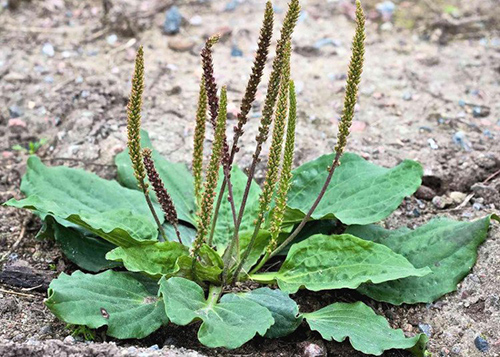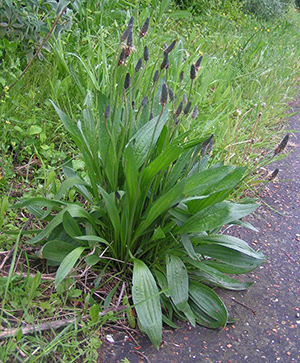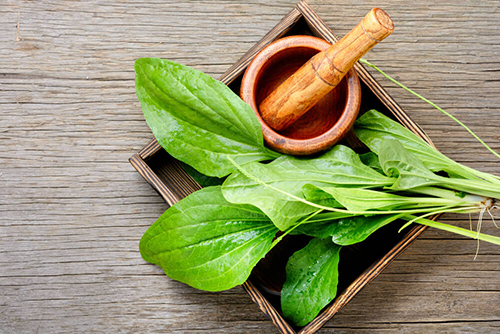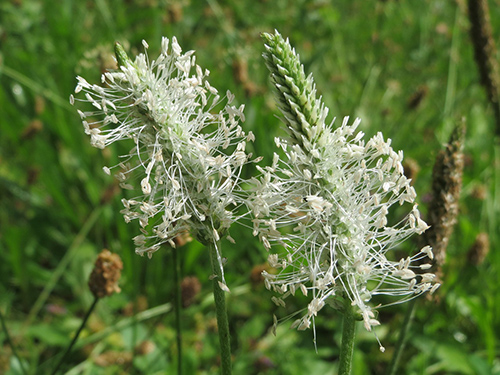Contents
The common plantain comes from the botanical genus Plantago. It comprises about 200 species, among which the most outstanding regarding their phytotherapeutic applications are psyllium and three species of plantain (lance-leaf plantain, common plantain, and hoary plantain), which have been used as medicinal herbs since the times of the ancient Greeks. The name Plantago refers to the footprint-like shape of their leaves.

Common Plantain Scientific Facts
- Similar species: Plantago media L (Hoary plantain), Plantago lanceolata L. (Lance-leaf plantain).
- Other names: (Common plantain): broad-leaved plantain, dooryard plantain, greater plantain, round-leaved plantain, waybread, white man’s foot. (Lance-leaf plantain): Buckthorn, chimney sweeps, English plantain, headsman, ribgrass, ribwort, ripplegrass, snake plantain, soldier’s herb. (Hoary plantain): Gray ribwort, wooly plantain.
- French: Plantain.
- Spanish: Llanten.
- Environment: It grows all over Europe and is naturalized in America. The common plantain grows in wet soils, the hoary plantain on roadsides and slopes, and the lance-leaf plantain in calcareous soils.
- Descriptions: The plant of the Plantaginaceae family grows from 10 to 60 cm high. All three species have root-growing leaves with parallel nerves that join at the leaf’s tip. The length and size of the leaves are different for each species, and the flower spikes.
- Parts of the plant used medicinally: The whole plant (leaves, flower spike, and root).
Healing Properties and Indications
All three species of plantain contain a large amount of mucilage, which gives them emollient, expectorant, antitussive, and bechic properties; tannin, to which they owe their astringent, hemostatic, and cicatrizant properties; pectin; and chromogenic glycosides (aucubine and catalpol), with anti-inflammatory and antiseptic properties.

The common plantain contains phenolic acids, flavonoids, choline, and noscapine, an alkaloid with antispasmodic and antitussive properties. Plantain soothes and dries simultaneously due to the combined action of mucilage (emollient, soothing) and tannin (astringent, which produces desiccation and constriction). This gives plantain an anti-inflammatory effect and helps heal many respiratory and digestive mucous membrane afflictions. These are their principal applications:
- Respiratory disorders: Acute or chronic bronchitis, bronchial catarrh, asthma. Plantain thins secretions, easing their elimination, reducing the inflammation of the bronchial mucous membrane, and easing coughs. It has been used against pulmonary tuberculosis and pneumonia to complement their specific treatment. Among these plants, the common plantain has more potent antitussive properties.
- Mouth and throat disorders are treated with gargles and mouth rinses. Plantain is recommended for stomatitis, gingivitis, pharyngitis, tonsilitis, and laryngitis. The plant’s active components reduce inflammation, heal itching and throat irritation, and alleviate coughing from whooping cough.
- Digestive disorders: colitis, aerocolia (gas in the colon), abdominal distension caused by an excess of gas or bad digestion, intestinal putrefaction, diarrhea, dysentery, chronic constipation with inflammation of the large intestine.
- Hemorrhoids: Sitz baths and enemas with a plantain decoction are very effective in reducing the inflammation of hemorrhoids.
- Eye ailments: A decoction of plantain, irrigated, alleviates eye diseases such as conjunctivitis and blepharitis (inflammation of the eyelids).
- Varicose ulcers, bleeding or suppurating wounds, burns. In these cases, you can apply compresses directly with a plantain decoction or plantain leaves previously blanched in boiling water.
- Insects and reptile bites: Dr. Leclerc states that weasels rub themselves on the plantain plants before fighting snakes to become protected against reptile poison. For bites of insects, spiders, bees, or scorpions, vigorously rub the affected area with plantain leaves, then apply a dressing or poultice made with plantain leaves.

In the case of snake bites, the usual emergency treatment is required (cutting the area, tourniquet, anti-poisonous serum), followed by lotion and a dressing or poultice with plantain leaves.
There are several types of plantain plants, but they all have comparable properties. The plant has cooling and soothing actions that make it practical for many ailments, such as excessive menstrual discharge, bronchitis, ulcers, diarrhea, inflammations, and infections. Prepare an infusion using an ounce of plantain in a pint of water. It performs as a diuretic and comforts the urinary tract and the lungs.
The plant is an excellent remedy for acute neuralgia; in this case, take two to five drops of tincture every twenty minutes. It can also treat enteritis, gastritis, hoarseness, and cough irritations. It is also helpful in treating all respiratory problems, primarily those involving mucus congestion. It is fantastic for heartburn and indigestion.

Plantain is beneficial in treating kidney and bladder infections and water retention. It can neutralize stomach acids, normalize all stomach secretions, and may inhibit the growth of tuberculosis bacteria. Plantain seeds are like psyllium seeds, and if taken in amounts of one teaspoon of powdered juice three times daily, it can provide a fantastic bulk laxative.
Soaking the seeds overnight will produce a gel. Bring the gel to a boil, turn it off, and let it steep for ten minutes. Squeeze the gel through a strainer to treat spitting up blood, intestinal pains, and ulcers. Introduce a cup of tea several times daily into the colon to treat hemorrhoids. You can also use it as a douche for vaginal ailments.
Intestinal worms, gastrointestinal difficulties, and chronic catarrhal problems can be treated using fresh juice from the whole plant. When applied to wounds and sores, it has an antibiotic, healing, and blood-stanching effect in external applications.
The plant can neutralize toxins in snake and insect bites. Place the freshly ground leaves (or slightly chewed) on the bites of bees, insects, and snakes. A dried leaf decoction can promote blood coagulation. You can apply it to eczema, carbuncles, and boils. The fresh juice extract is excellent for itchy skin. Simultaneously swallow a tablespoon of the fresh juice.
Plantain is a fantastic remedy for chronic skin problems, scratches, cuts, and infections. It is utilized in various ointments and salves alone or mixed with other herbs like angelica, mugwort, comfrey, and chickweed. Fresh leaves can be applied to hemorrhoids, ringworms, insect bites, sores, and even wounds. Chewing the rootstock can also relieve toothache.
The Asian plantain, P Asiatica, is a clinical treatment for high blood pressure at a fifty percent success rate. Common plantain is a well-known folk cancer remedy in Latin America. It is used for this purpose worldwide. The plant also stimulates the healing process and is an antimicrobial.
How to use Common Plantain
- Decoction.
- Leaf dressings
- Poultices of boiled and mashed leaves.
Infusion (leaf): Steep for five to fifteen minutes and take three ounces three to four times daily. Decoction (seed): Simmer one ounce of seeds in 1 ½ pints of water, reduce to one pint, sweeten with honey, and take one tablespoon three to four times daily. Tincture: Take two to sixty drops three to four times daily. Fluid Extract: Take ½ to one teaspoon three to four times daily. Powder: Take up to ten #0 capsules (up to 60 grains) three to four times daily.
DISCLAIMER: All content on this website is presented solely for educational and informational objectives. Do not rely on the information provided as a replacement for advice, diagnosis, or treatment from a qualified medical expert. If you are pregnant, nursing, or have any preexisting medical concerns, talk to your doctor before using any herbal or natural medicines.
REFERENCES
- George D. Pamplona-Roger, M.D. “Encyclopedia of Medicinal Plants.” George D. Pamplona-Roger, M.D. Encyclopedia of Medicinal Plants. Ed. Francesc X. Gelabert. Vols. 1 San Fernando de Henares: Editorial Safeliz, 2000. 325, 326. Print.
- Vance Ferrell Harold M. Cherne, M.D. The Natural Remedies Encyclopedia [Book]. – Altamont, TN: Harvestime Books, 2010. – Vol. Seventh Edition: 7: pp. 174, 175.
- https://www.ncbi.nlm.nih.gov/pmc/articles/PMC5878035/
- https://www.peacehealth.org/medical-topics/id/hn-2148003
- https://www.tuasaude.com/en/broadleaf-plantain/
- https://www.webmd.com/vitamins/ai/ingredientmono-677/great-plantain
